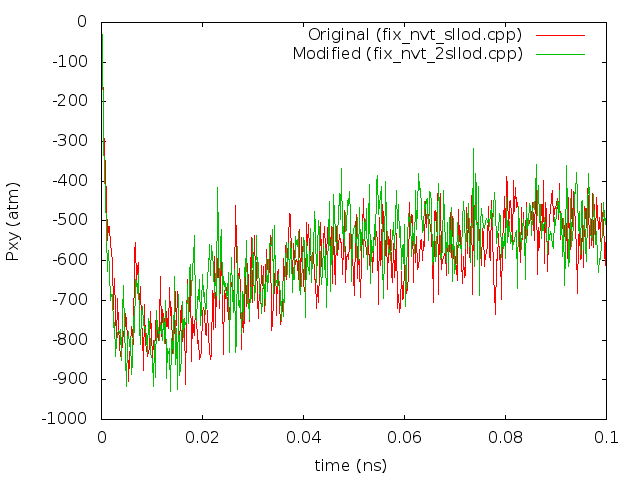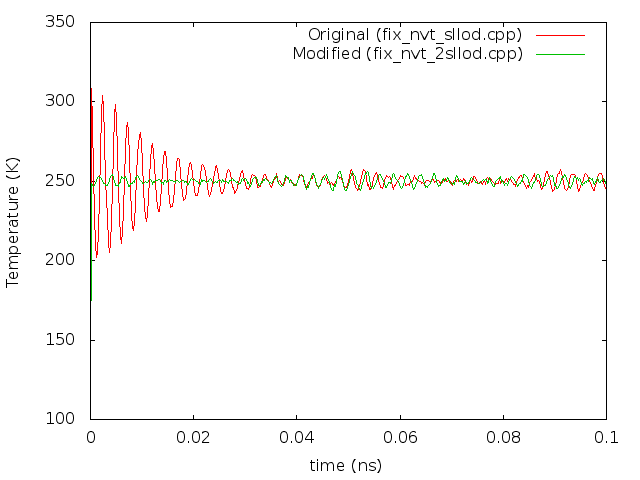Hello Users and Developers,
I have recently been looking into the SLLOD implementation with interest in making a new “fix” which will integrate the SLLOD equations in the NPT ensemble (of type “iso”) and I noticed some details about the current implementation which I though were worth mentioning. I think there might be a small inconsistency in the SLLOD code as well, so if you are interested only in that, please skip to 2.
- The current version of SLLOD is thermostat driven, which causes oscillations during startup.
I’m pretty sure you already know that this is the case, but I’ll explain anyway. If SLLOD is turned on without the presence of an initial flow field, the velocities will be thermostatted to the streaming velocities. This will result in some temperature oscillations due to the thermostat until the streaming velocities are obtained. One way to avoid this would be to impose an initial velocity profile over the thermal velocities which were present before the fix_deform command began.
Another approach is to remap positions when the box is deformed, and integrate the original velocities as thermal velocities. I implemented this approach in the files “fix_nvt_2sllod(.h/.cpp)” (which requires a fix_deform command with the option “remap x”, no need to remap v because the velocities are thermal. This also allows for use of unbiased calculation of the temperature and pressure in the system, but this is only a minor convenience. I made a plot for a comparison of the temperatures for the two methods during startup of shear for a polymer system in “T_shear.png” to show the oscillations in the original method, and also a plot of Pxy in “Pxy_shear.png” which seems to show the same behaviour for both methods. I did notice that my version ran a little faster, around ~3% (maybe there is some overhead associated with remapping velocities?), but this may be due to the oscillations in the original implementation which will become less important with time. Maybe this form of the fix is something to look into?
- I think the current version of SLLOD is actually GSLLOD (which is the same for shear, but not in general)
I think this may have been inadvertent, based on the following code and comments on “fix_nvt_sllod.cpp”:
comment on line 103:
// vdelu = SLLOD correction = HrateH_invvthermal
code to implement this lines 115-129:
double h_two[6],vdelu[3];
MathExtra::multiply_shape_shape(domain->h_rate,domain->h_inv,h_two);
for (int i = 0; i < nlocal; i++) {
if (mask[i] & groupbit) {
vdelu[0] = h_two[0]*v[i][0] + h_two[5]*v[i][1] + h_two[4]*v[i][2];
vdelu[1] = h_two[1]*v[i][1] + h_two[3]*v[i][2];
vdelu[2] = h_two[2]*v[i][2];
temperature->remove_bias(i,v[i]);
v[i][0] = v[i][0]factor_eta - dthalfvdelu[0];
v[i][1] = v[i][1]factor_eta - dthalfvdelu[1];
v[i][2] = v[i][2]factor_eta - dthalfvdelu[2];
temperature->restore_bias(i,v[i]);
}
}
Notice that vdelu is calculated before the bias is removed, but the comment mentions that the correction should be using vthermal. I believe this makes the current scheme equivalent to GSLLOD because the velocity contains the streaming velocity (q.delu) and the velocity relative to it (vthermal):
v = q.delu + vthermal
When this is multiplied by delu, this means that as calculated, vdelu above is equal to:
q.(delu).(delu) + vthermal(delu)
which is the correction for the GSLLOD equations of motion. To get the regular SLLOD equations, I think the “temperature->remove_bias(i,v[i]);” line could just be moved up above the calculation of vdelu (I tried this fix, but only have done shear simulations which resulted in the same behaviour, as expected, until divergence due to numerics took over after about 20 ps).
P.S. I also have a preliminary version of SLLOD with NPT integration if anyone is interested; just let me know.
Thanks,
David


fix_nvt_2sllod.cpp (3.34 KB)
fix_nvt_2sllod.h (1.1 KB)